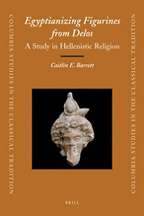The sectarian wars raging around the globe attest to the rigidity of many religious outlooks today. But in the second century BCE, residents on the Greek island of Delos saw nothing wrong with using others' gods in their prayers.
"What's interesting is the degree to which these foreigners -- Italians, Phoenicians, Egyptians, Syrians and Jews -- interacted with each other's deities and the cross-pollination among worshipers," says Caitlin Barrett, assistant professor of classics and author of the newly published 831-page "Egyptianizing Figurines From Delos: A Study in Hellenistic Religion" (Brill 2011).
Barrett examined terracotta figurines found on Delos to determine what influence Egypt's religion had on the Hellenized inhabitants and their daily lives. "Terracotta figurines represent potential evidence for the religious ideas of a wide swath of the population, not just the rich," says Barrett. Such inexpensive figurines were accessible to many because they could be made rapidly and in bulk.
Although most of the figurines were produced by local craftspeople, many of them have iconography reminiscent of Egyptian deities. The Greco-Macedonian Ptolemies ruling Egypt at this time worshiped the Greek gods, not just the traditional Egyptian pantheon. "This led to the creation of syncretic imagery that combined aspects of both Greek and Egyptian traditions, and that could speak to members of this heterogeneous population. Some of that imagery wound up becoming hugely popular in the rest of the Mediterranean as well," says Barrett.
The image of the Greek god Harpocrates on Barrett's book cover, for example, shows how Delian craftsmen used techniques of figurine manufacture and conventions of artistic style that derive from Greek traditions, while conveying concepts that are fundamentally very Egyptian. Barrett explains that Egyptians depict children with a finger to the mouth (because babies put fingers in their mouths) rather than with child-like features or a smaller size."
But there are dangers with appropriating another religion's iconography. Later Greek writers misinterpreted the Egyptianized gesture of Harpocrates to mean that he was shushing people, and eventually he became repurposed as the god of silence. "Images like this testify to the continuity of certain religious traditions throughout the Mediterranean, but at the same time their transformation," says Barrett.
Figurines of Egyptian gods appear as offerings at Greek gods' temples on Delos and vice versa. "The fact that somebody's dedicating a figurine of a Greek goddess like Aphrodite to an Egyptian goddess like Isis suggests that the two were associated, or at least that their worship wasn't considered incompatible," explains Barrett. "Greeks saw these other gods not as alternatives to the Greek pantheon but as something compatible with their own traditions."
Barrett's latest project is the influence of Egyptian religion in Italy. She plans to do research in Pompeii in summer 2012.
Provided by Cornell University






















